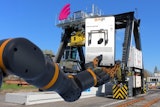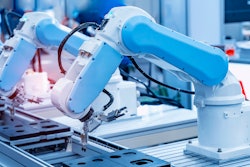
 Steve Smith
Steve SmithTechnology buzzwords like artificial intelligence (AI), machine learning and the Internet of Things (IoT) create a lot of hype among manufacturing professionals. More than the latest fad, these technologies are setting the bar for efficiency and forcing companies to revisit business plans and find a way to incorporate them.
Conversations linking manufacturing and artificial intelligence aren’t without concerns regarding the displacement of human workers with machines. Workers are increasingly nervous that machines may oust them, but according to McKinsey, while 51 percent of work tasks can be automated, only 5 percent of occupations can be automated. There’s little doubt that there are specific tasks for which artificial intelligence is well suited, but humans are—and will always be—needed to carry out some jobs. The combination of human talent and current technology optimizes workflow, increases efficiency and bolsters profits. But one without the other? That’s yet to be proven successful.
AI Defined
To differentiate between the hype and the reality of AI, machine learning and IoT, and determine how to best implement them into your business plan, it is essential to understand the key components of each. AI can produce output with quality as good as, or better than a human can. This often involves an element of automation. Machine learning is a subset of artificial intelligence in which computers discern patterns that indicate future performance. For, example, this might include identifying which aspects of a task influence the length of time it takes. The data is collected from sensors or other connected device, otherwise known as IoT.
In manufacturing, these technologies don’t replace the human worker, but offer the opportunity to optimize processes and, using data, predict future problems, freeing up employees to handle more sophisticated problems. Efficient factories spell higher profits and money saved when used in ways that serve both machine and human.
AI and Scheduling
Artificial intelligence is especially well suited for scheduling. The process of sending technicians to repair critical equipment is time consuming, tedious, and, if done using yesterday’s processes, an inefficient use of resources. That’s because a variety of factors affect the need to reschedule a service appointment, including inaccurate estimated travel time and work duration, incorrect or missing parts and even weather conditions. Schedule adjustments are typical, but for efficiency’s sake, they must be done quickly, and humans don’t always have the complete data to solve the problem expediently. Small issues turn into large logistical problems.
Incorporating AI into your scheduling allows managers to estimate travel time and optimize the technician’s route, taking into account weather and traffic conditions. Based on history and task type, it can also flag customers that are a higher risk for cancellation and respond proactively and efficiently. This saves valuable time, not only for the technician, who can now attend to other work, but for customers too.
AI and Predictive Maintenance
When combined with the Internet of Things, AI can also help proactively schedule appointments based on maintenance history. Manufacturing companies cannot afford to lose valuable time and productivity when there are unplanned equipment failures. Predictive intelligence provides an alert before machines break, enabling the company to preemptively schedule time to repair or replace a part without suffering any downtime, keeping the factory floor running on time and limiting disruptions.
Future Technology is Here Today
Artificial intelligence is not tomorrow’s technology—manufacturing centers and factories are already using it. Some factories are using robots managed by human workers, to perform automated tasks that are coordinated along the supply chain. Amazon has developed a system of connected robots to optimize fulfillment center service by shortening the time spent searching for a product within the warehouse and increasing the number of orders fulfilled in day.
It makes sense that AI makes workers nervous. From the fear of automation replacing jobs, to angst around the disruption of existing processes, AI offers a lot of value, but it also drives uncertainty. But what is certain is that AI and other technologies are a large part of the future of work, and those who see past the hype and leverage it responsibly, will see efficiency gains. AI enables organizations to limit the time human workers spend on repetitive and time-consuming tasks and optimizes the entire workflow to maximize efficiency, cut costs and maintain a competitive advantage.
Steve Smith is VP of Strategic Industries at ClickSoftware.























